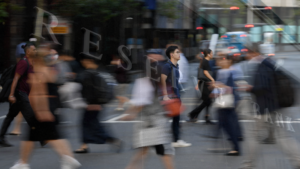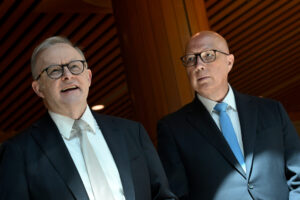by Richard Denniss
[Originally published on Guardian Australia, 13 May 2020]
The government is telling us that if we don’t open up the Australian economy soon, we will do lasting harm to it. But the forecasters at Treasury and the Reserve Bank are relying on economic models that assume the deeper the recession we have, the faster our recovery will be. So, which is it: do recessions cast a long shadow or don’t they?
While Scott Morrison has quietly dropped his “snap back” rhetoric, the idea of a “business-led recovery” in the second half of the year is now baked into the government’s policy settings. Those benefiting from the jobseeker supplement or the jobkeeper payment are being told their payments will be wound back in less than six months’ time, even though unemployment will remain high for years to come.
The treasurer, Josh Frydenberg, says he must cut government spending in the second half of the year, as “there is no money tree” to keep supporting workers or businesses. But does he think workers and businesses have money trees of their own? With record unemployment coming our way and a world economy headed for recession, where does Frydenberg think employers will find the money to pay their staff and workers will find money to pay their rent if his government pulls the pin on fiscal stimulus midway through this crisis?
The reason firms pay workers to make things is because customers pay firms to have those things. While the Morrison government is still obsessed with the idea that cutting the company tax rate will make firms invest in bigger factories, every CEO and board in the country is obsessed with whether customers will be able to afford to buy their stuff once the shops, gyms and restaurants begin to open up again. Businesses do not lead recoveries, they respond to them, and until the customers start buying more stuff than the companies can make, the companies aren’t going to waste money expanding their production capacity.
The economic models governments use to predict the future have never had a good track record. The Coalition has delivered six budgets since winning office in 2013, and Treasury has overestimated wage growth in all six of them. But those errors are trivial compared to the bizarre assumptions those same models make about the long-run impact of the deepest recession in a century.
Economic models usually deal with recessions by assuming they don’t really matter. Of course, economic modellers know that “negative shocks” hit the economy from time to time, but they also know that positive shocks hit the economy from time to time as well. If you assume that the positive and negative shocks cancel each other out, guess what? You don’t have to worry too much about the long-run consequences of some short-term pain.
Again, modellers know that there are both bumps and potholes in the road, but if you assume that the bumps and dips even each other out you can, in the words of the Reserve Bank of Australia, build models with an “error-correction architecture”. This forecasting approach expects that if the economy is booming then it will, most likely, slow down a bit soon. And if the economy is in a recession, it will probably speed up again soon. Such simplifying assumptions allow economists to pretty much ignore the short-term path the economy is on. But a problem ignored is not a problem solved.
In 1991 the Australian economy went into a six-month recession which saw GDP fall by 1.4%. If that was a pothole then the 10% recession the RBA and Treasury are predicting for this year is a virtual cliff. But does anyone really believe the assumption that the higher the cliff, the better a car will bounce back? That if Covid-19 caused our economy to collapse by 20%, the economy would snap back twice as fast as we are assuming it will in response to the 10% recession we are expecting?
It’s not just dodgy modelling assumptions that cause problems for economic policy making; dodgy metaphors are just as dangerous. Assuming that the depth of a recession determines the strength of the recovery – and talking about the ability of an economy to snap back – implies that nature, not policy makers, will determine what happens to the economy in the coming years. Economic history and theory suggest that the opposite is the case. It was massive public spending programs that brought the Great Depression to an end, not natural forces. It was Labor’s fiscal stimulus that stopped Australia going into recession after the global financial crisis, not market forces.
The economy will snap back after falling off a 10% cliff no better than the front of your car would snap back after driving off a 10-metre cliff. Just as it takes time, effort and skill to reshape a car after a crash it takes time, effort and skill to put an economy back together. Particularly after its biggest downturn in a century.
It’s not ideological to say that business can’t lead us out of this recession, it’s economics. Economists typically break the economy up into four sectors: consumer spending, private sector investment, government spending and net exports. When we talk about the size of GDP, we are literally talking about the sum of those four parts. Let’s think about what’s likely to happen to those parts.
We know that unemployment is set to rise dramatically, and the number of people moving to Australia will fall dramatically. While there’s likely some pent-up demand for restaurants, movies and holidays, it’s hard to see a big, sustained increase in consumer spending dragging us back up the Covid-19 cliff in the next few years.
As most of the rest of the world is being hit harder than Australia by Covid-19, it’s unlikely that foreign demand for our exports is booming any time soon either, especially since big export earners such as tourism and education will be largely shut off from their customers for some time yet.
And while Frydenberg has been talking like a Keynesian who sees a role for government spending to stimulate the economy, he isn’t acting like one when he says he will cut government spending in the second half of this year.
Then there’s private business investment. If domestic and foreign consumers are spending less money and the government is spending less money, why would private businesses choose – in the middle of a pandemic and recession – to spend up big on new factories, or anything else? Business investment was already at record lows in 2019, so why would anyone, other than an economic modeller, assume that means this year it would have to pick up?
The government is right to try and get the economy moving as soon as it is safe to do so because, no matter what the economic models assume, deep recessions do not cause their own recoveries. And the fact that deep recessions don’t cause their own recoveries is precisely why the Morrison government has to ditch not just the metaphor of snap back, but the policies based on that metaphor.
The Australian economy does not need temporary and targeted stimulus. It needs hundreds of billions of dollars’ worth of new public policies and investment to fill the gaping hole that Covid-19 has dug into our economy. And the sooner they get started on those policies, the sooner unemployment will fall.
• Richard Denniss is chief economist at the independent thinktank the Australia Institute
Between the Lines Newsletter
The biggest stories and the best analysis from the team at the Australia Institute, delivered to your inbox every fortnight.
You might also like
Business groups want the government to overhaul the tax system? Excellent – we have some ideas.
The landslide win by the ALP has seen business groups come out demanding the government listen to their demands despite having provided them no support, and plenty of opposition, over the past 3 years.
Would you like a recession with that? New Zealand shows the danger of high interest rates
New Zealand’s central bank raised interest rates more than Australia and went into a recession – twice.
5 ways and 63 billion reasons to improve Australia’s tax system
With a federal election just around the corner, new analysis from The Australia Institute reveals 63 billion reasons why our next Parliament should improve the nation’s tax system.



